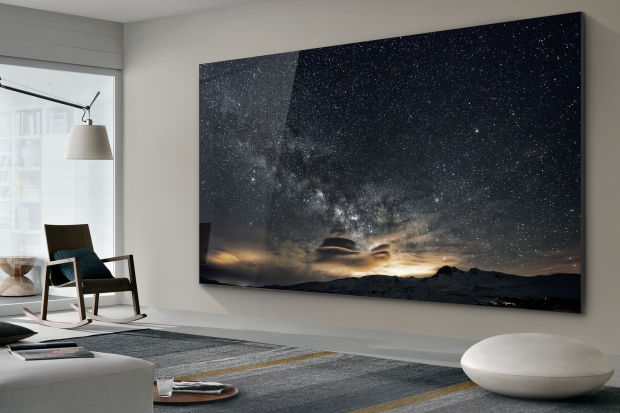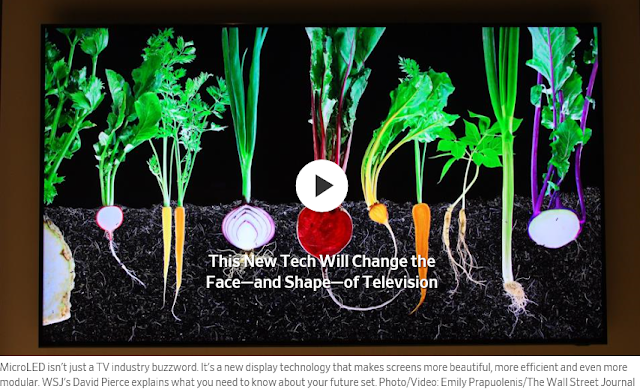This Really Is the Next Revolution in TV Technology
MicroLED is better looking, more efficient and more versatile than any previous display tech. Now all Samsung, Sony, LG and others have to do is figure out how to manufacture it affordably
By David Pierce
https://m.wsj.net/video/20190108/010819microled/010819microled_v2_ec664k.mp4
LAS VEGAS—One of the most exciting things I’ve seen at this year’s CES tech show was a man putting a TV together. It looked more like he was hanging photos. He’d grab square tiles off a pile, attach them to the wall, then screw a small plate up top. A moment later, the surface would spring to life. He’d attach another, and it would extend the picture. He built a TV one tile at a time, and it looked awesome.
This particular set was a prototype of a new Samsung modular TV project. At CES, the company displayed screens as small as a magazine cover and as large as 219 inches—which it called, aptly enough, The Wall. Samsung’s goal is to let customers choose the exact size and shape of their own TV, assembled like Lego bricks.
https://m.wsj.net/video/20190109/010919bestces/010919bestces_v2_ec664k.mp4
You won’t be able to buy The Wall for a while—and even then it’ll likely only be affordable to people who already own several yachts—but in the meantime, Samsung intends to sell a 75-inch 4K TV based on the same technology. It’s called MicroLED, and it’s worth knowing about now, because it’s the biggest change coming to screens in a long time.
Painting the Picture
For years, LCD (aka liquid crystal display) has been the dominant TV tech. But LCD has a downside: Its pixels basically sit in a sheet of glass, and can’t be seen well unless there’s a big light—or many little lights—shining through it. Without the light, your TV would look more like an Amazon Kindle. Backlighting, though, means dark colors can only be so dark.
More recently, a technology called OLED (aka organic light emitting diode) has hit the high end of the market. Rather than light needing to hit every pixel, or big clusters of pixels, the pixels can light up individually. That’s good for power consumption and great for picture quality: Any pixel that’s supposed to be black just stays off, which means deeper colors and better contrast. But OLED relies on organic compounds (hence the name), which degrade over time and can cause screen problems.
MicroLED is, at least in theory, the best of all worlds. A MicroLED screen is made up of massive numbers of the teeny tiny versions of the LEDs you already know and love. Each is self-powered so it can have similar image quality to OLED, but MicroLED’s inorganic material won’t degrade over time or cause screen burn-in. MicroLED is smaller, thinner and brighter, too, so its displays can be even flatter and less power-hungry.
An advantage of MicroLED is that it can be built into tiles that fit seamlessly together, making a TV as large or small as needed. Photo: Emily Prapuolenis/The Wall Street Journal
“MicroLEDs are the most interesting and exciting new display technology since the launch of OLED display products beginning in 2010,” said Ray Soneira, chief executive of DisplayMate, a display-technology research company.
Make It So
Samsung may have had the largest MicroLED display at CES—and may be hitting the market soonest with the first living-room-targeted set—but many other companies are working with the technology. TV giants LG and Sonyhave shown off MicroLED displays of their own. In 2014, Apple acquired a company called LuxVue that was also working on MicroLED displays.
Traditional TV sizes go away with this technology, which can be shaped into vertical, elongated or even square sets. Photo: Emily Prapuolenis/The Wall Street Journal
In some ways, the tech may be even better for smaller screens like phones or smartwatches, or future devices like VR headsets and AR glasses. Your phone’s display accounts for a huge amount of its battery drain. Who wouldn’t want a screen that uses less power, looks better and can change its shape and size?
Your MicroLED TV is a long way off. “A very high proportion of displays using MicroLEDs will not happen in the next few years,” said Jamie Fox, an analyst with research firm IHS Markit . “It is still quite early in the progress of this technology.” As much as anything, it’s a manufacturing challenge: Your Samsung Wall would require careful placement of millions of tiny sub-pixels, each smaller than a human hair. That’s expensive, difficult and slow, three words nobody likes coming off the factory line.

For those for whom cost is no object, Samsung has The Wall, a monstrous, modular MicroLED TV that has grown in size. Last year, it was 146 inches, and now it’s 219 inches. Photo: Samsung
Still, MicroLED is the display technology to watch in the coming years. When MicroLED manufacturing ramps up, and costs go down, the idea of dotting every surface with pixels won’t sound crazy. William Shakespeare famously wrote, “All the world’s a stage.” More likely, someday not too far off, all the world will be a screen.




0 comments:
Publicar un comentario